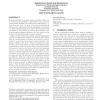IPPS
2005
IEEE
13 years 10 months ago
2005
IEEE
— We consider a dense wireless sensor network where the radio transceivers of the sensor nodes are heavily duty-cycled in order to conserve energy. The chief purpose of the senso...
ICW
2005
IEEE
13 years 10 months ago
2005
IEEE
— Ad hoc and wireless sensor networks have recently emerged as successful technologies in a number of application domains. The need to build security services into them remains h...
CEC
2005
IEEE
13 years 10 months ago
2005
IEEE
With the emergence of wireless sensor networks and pervasive computing, innovative location-aware technologies and services are being investigated. Several iterative approaches emp...
BROADNETS
2005
IEEE
13 years 10 months ago
2005
IEEE
— Lightweight protocols that are both bandwidth and power thrifty are desirable for sensor networks. In addition, for many sensor network applications, timeliness of data deliver...
WS
2006
ACM
13 years 10 months ago
2006
ACM
This paper presents SCUBA (Secure Code Update By Attestation), for detecting and recovering compromised nodes in sensor networks. The SCUBA protocol enables the design of a sensor...
SASN
2006
ACM
13 years 10 months ago
2006
ACM
Wireless sensor networks are typically deployed to measure the information field, rather than create an information field. However, by utilizing the radio on sensor nodes, it is...
SASN
2006
ACM
13 years 10 months ago
2006
ACM
A great challenge in securing sensor networks is that sensor nodes can be physically compromised. Once a node is compromised, attackers can retrieve secret information (e.g. keys)...
VTC
2006
IEEE
13 years 10 months ago
2006
IEEE
Abstract— In wireless sensor networks (WSNs), reducing energy consumption of resource constrained sensor nodes is one of the most important issues. In this paper, we propose a ta...
SAMOS
2007
Springer
13 years 10 months ago
2007
Springer
For most applications in wireless sensor networks (WSNs), it is often assumed that the deployment of sensor nodes is unmanaged and random, so the density of local node may vary thr...
ICOIN
2007
Springer
13 years 10 months ago
2007
Springer
Wireless Sensor Network (WSN) deployed in hostile environments suffers from severe security threats. In this paper, we propose a Secure Message Percolation (SMP) scheme for WSN. We...

